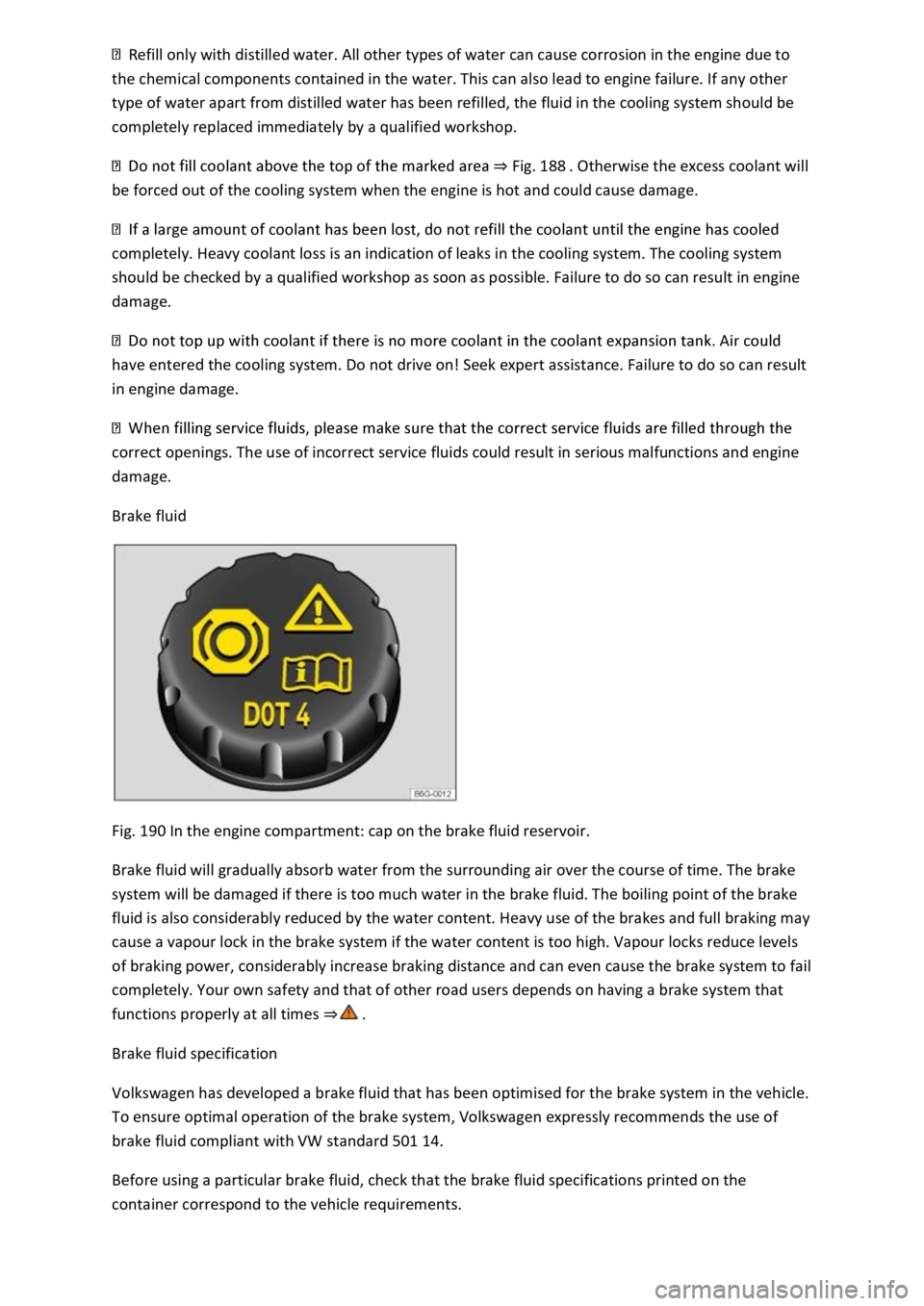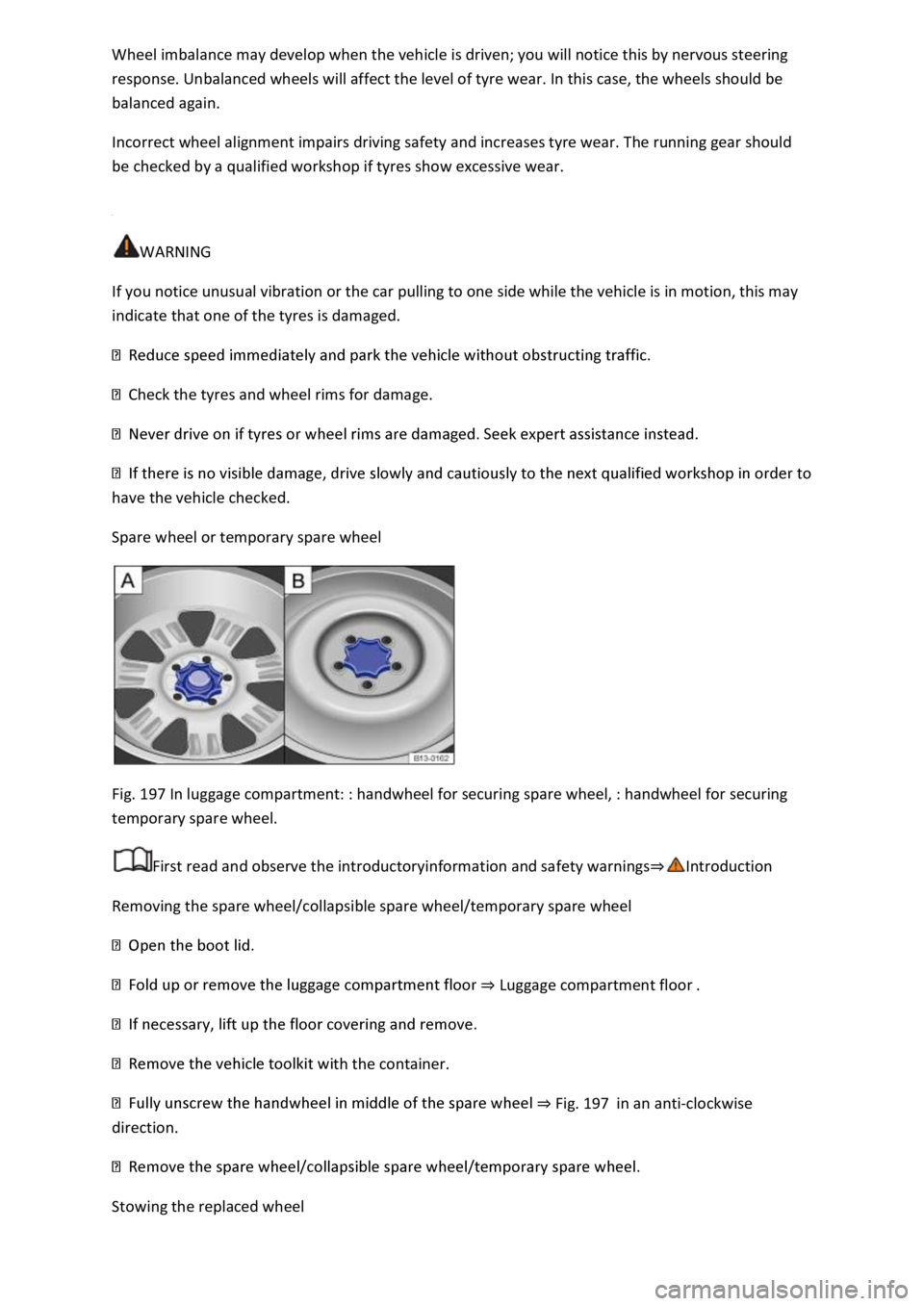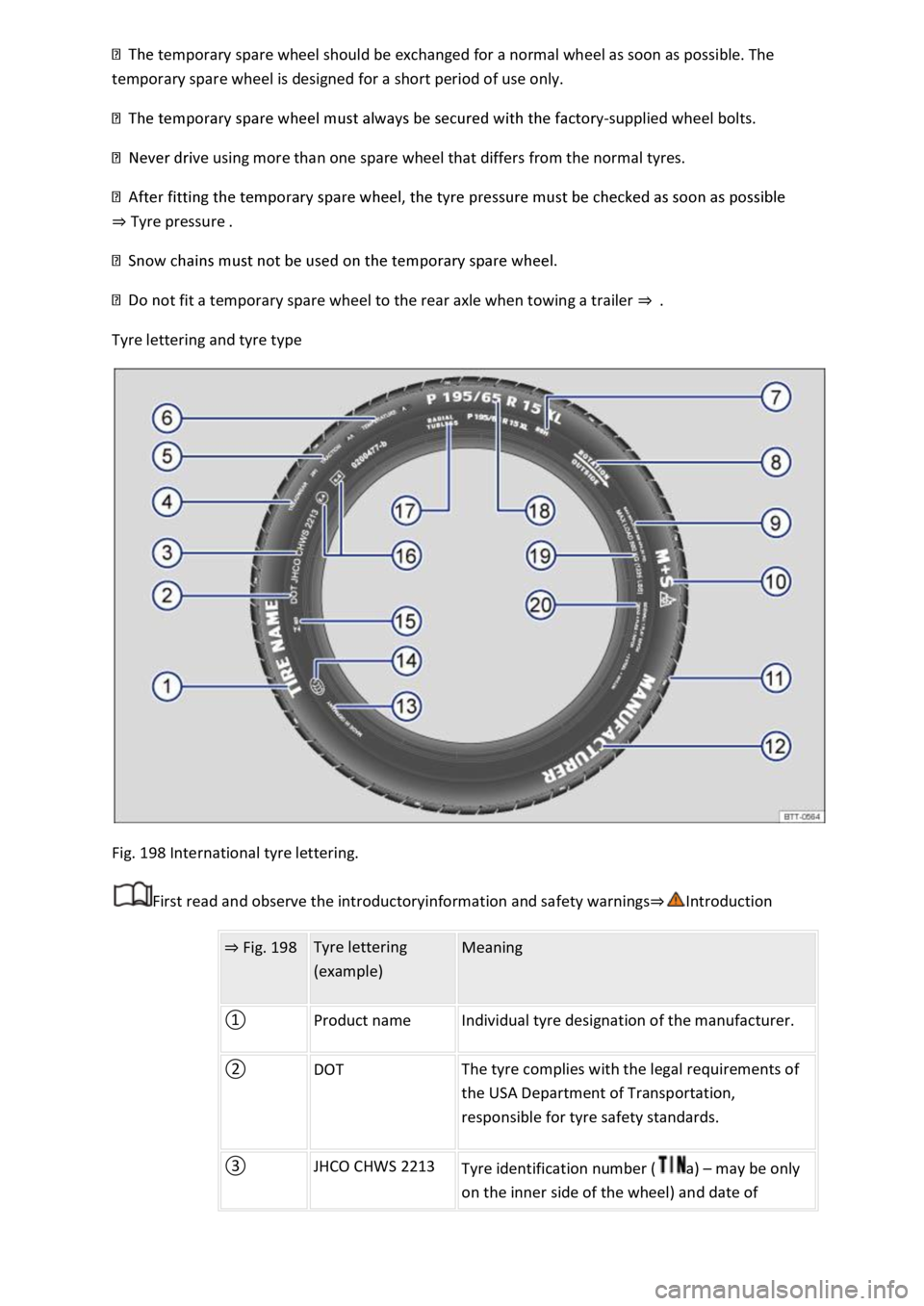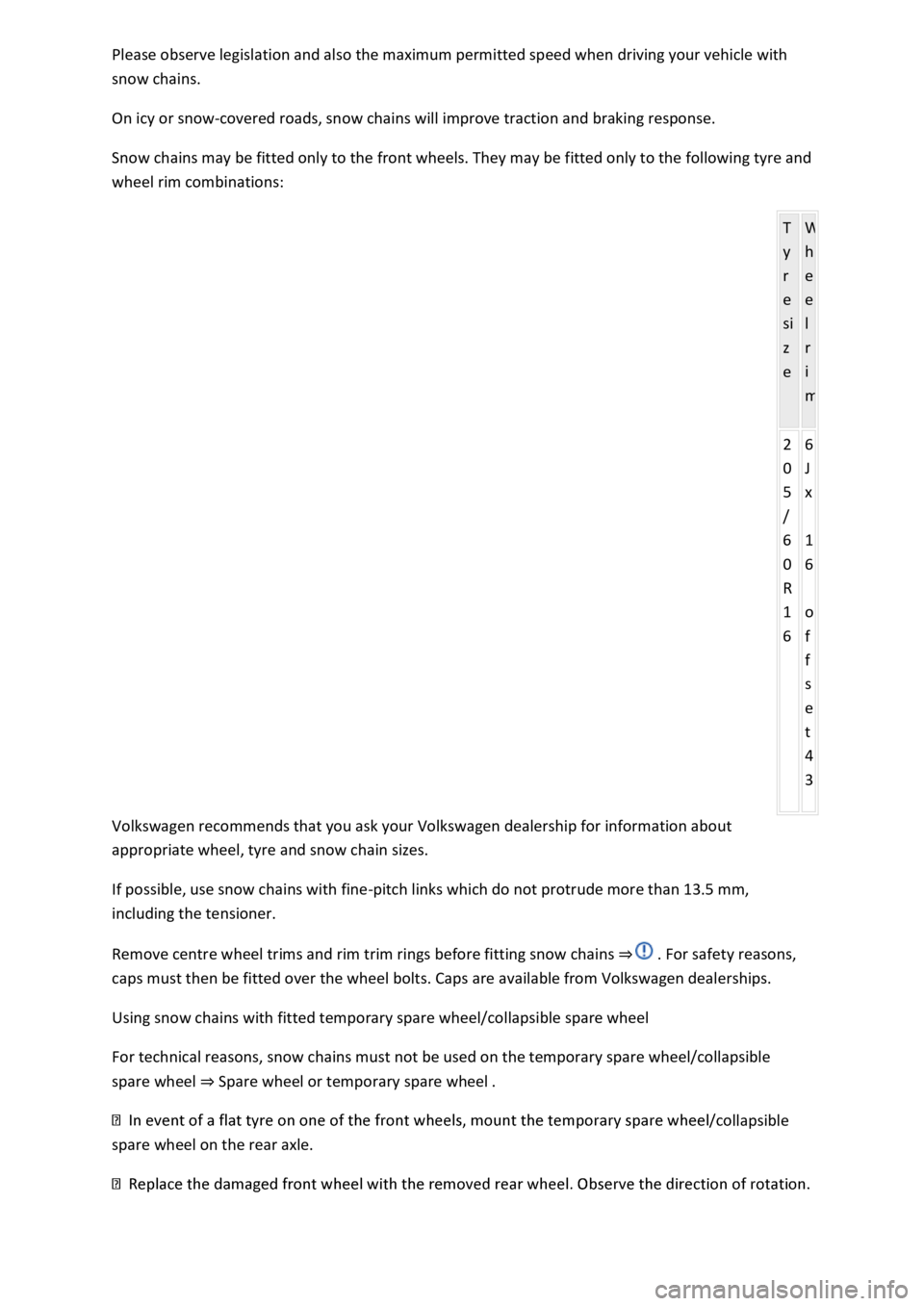2018 VOLKSWAGEN T-ROC ESP
[x] Cancel search: ESPPage 378 of 502

Introduction
This chapter contains information on the followingsubjects:
Coolant specification
Checking the coolant level and refilling coolant
Do not work on the cooling system unless you are familiar with the task, aware of the general safety
procedures and have the correct equipment, service fluids and suitable tools. Serious injuries can be
caused by carrying out work incorrectly
workshop if you are uncertain. Volkswagen recommends using a Volkswagen dealership for this
purpose.
WARNING
Coolant is toxic.
ce.
-original containers as
people finding these containers may then drink the coolant.
ct coolant additive used must be sufficient for the lowest
ambient temperature that you expect the vehicle to be exposed to.
Vehicle occupants with inadequate winter clothing could then freeze to death as the heating will
also no longer function.
Coolant and coolant additives can pollute the environment. Spilt service fluids must be collected
then disposed of properly and in an environmentally responsible way.
Coolant specification
First read and observe the introductoryinformation and safety warnings
The cooling system is filled at the factory with a mixture of specially prepared water and at least 40%
coolant additive G 13 (TL-VW 774 J).
The proportion of engine coolant additive must always be at least 40% to protect the cooling system.
If greater frost protection is required in very cold climates, the proportion of anti-freeze additive can
be increased. However, the percentage of coolant additive should not exceed 60%, as this would
reduce the frost protection again and the cooling effect.
Page 382 of 502

Refill only with distilled water. All other types of water can cause corrosion in the engine due to
the chemical components contained in the water. This can also lead to engine failure. If any other
type of water apart from distilled water has been refilled, the fluid in the cooling system should be
completely replaced immediately by a qualified workshop.
Fig. 188
be forced out of the cooling system when the engine is hot and could cause damage.
completely. Heavy coolant loss is an indication of leaks in the cooling system. The cooling system
should be checked by a qualified workshop as soon as possible. Failure to do so can result in engine
damage.
have entered the cooling system. Do not drive on! Seek expert assistance. Failure to do so can result
in engine damage.
correct openings. The use of incorrect service fluids could result in serious malfunctions and engine
damage.
Brake fluid
Fig. 190 In the engine compartment: cap on the brake fluid reservoir.
Brake fluid will gradually absorb water from the surrounding air over the course of time. The brake
system will be damaged if there is too much water in the brake fluid. The boiling point of the brake
fluid is also considerably reduced by the water content. Heavy use of the brakes and full braking may
cause a vapour lock in the brake system if the water content is too high. Vapour locks reduce levels
of braking power, considerably increase braking distance and can even cause the brake system to fail
completely. Your own safety and that of other road users depends on having a brake system that
functions properly at all times
Brake fluid specification
Volkswagen has developed a brake fluid that has been optimised for the brake system in the vehicle.
To ensure optimal operation of the brake system, Volkswagen expressly recommends the use of
brake fluid compliant with VW standard 501 14.
Before using a particular brake fluid, check that the brake fluid specifications printed on the
container correspond to the vehicle requirements.
Page 398 of 502

lace tyres at least on an axle-by-axle basis
type.
-approved tyres.
Re-synchronising the Tyre Pressure Loss Indicator
The Tyre Pressure Loss Indicator must be re-synchronised each time one or more wheels is changed.
This also applies if the wheels have been swapped, e.g. from the front to the rear Tyre monitoring
system
WARNING
Aggressive liquids and other substances can cause visible and invisible damage to the tyres, which
can cause the tyre to burst.
from the tyres.
WARNING
Even if they have not been used, old tyres can suddenly lose pressure or burst, especially at high
speeds, and thus cause accidents and serious injuries.
ith
extra care at all times.
WARNING
New tyres must be run in as they initially have reduced grip and braking efficiency.
km in order to prevent accidents and serious injury.
WARNING
Wheels must have the necessary clearance. If the wheels do not have the necessary clearance, the
tyre could rub on parts of the running gear, vehicle body and the brake lines. This can lead to a fault
in the brake system and to tread separation and thus to a tyre bursting.
and must not rub on any vehicle body parts.
Page 399 of 502

Avoid heavy impacts and drive round obstacles whenever possible. Tyres can be deformed by
potholes and kerb edges especially. This can cause damage to the tyres and wheel rims.
Old tyres should be disposed of as required by legislation.
Volkswagen-approved tyres are guaranteed to have the dimensions that are suitable for the vehicle.
In the case of other tyres, the tyre seller must provide a certificate from the tyre manufacturer
stating that the tyre is also suitable for the vehicle. This certificate must be stored in a safe place in
the vehicle.
Wheel rims and wheel bolts
First read and observe the introductoryinformation and safety warnings
Wheel rims, tyres and wheel bolts are matched to the vehicle type. If different wheel rims are fitted,
the correct wheel bolts with the correct length and correctly shaped bolt heads must be used.
For technical reasons, it is not generally possible to use the wheel rims from other vehicles. This can
also apply to wheel rims of the same vehicle type.
The tightening torque of the wheel bolts must be checked regularly with a properly functioning
torque wrench.
Wheel bolts
The correct wheel bolts must be used for each vehicle type; these bolts must always be tightened
with the correct tightening torque Wheel bolts
Wheel rims with bolted rim rings or trim elements
Rims with bolted-on rings or trim elements consist of several components. These components are
joined together using special bolts. Damaged wheel rims must be replaced and must always be
repaired only by a qualified workshop. Volkswagen recommends using a Volkswagen dealership for
this purpose
Wheel rim identification
In some countries, new wheel rims must contain information on certain properties. The following
information may appear on the wheel rim:
ed (month/year)
Page 404 of 502

response. Unbalanced wheels will affect the level of tyre wear. In this case, the wheels should be
balanced again.
Incorrect wheel alignment impairs driving safety and increases tyre wear. The running gear should
be checked by a qualified workshop if tyres show excessive wear.
WARNING
If you notice unusual vibration or the car pulling to one side while the vehicle is in motion, this may
indicate that one of the tyres is damaged.
Check the tyres and wheel rims for damage.
have the vehicle checked.
Spare wheel or temporary spare wheel
Fig. 197 In luggage compartment: : handwheel for securing spare wheel, : handwheel for securing
temporary spare wheel.
First read and observe the introductoryinformation and safety warnings
Removing the spare wheel/collapsible spare wheel/temporary spare wheel
Luggage compartment floor
th the container.
Fig. 197in an anti-clockwise
direction.
Stowing the replaced wheel
Page 406 of 502

temporary spare wheel should be exchanged for a normal wheel as soon as possible. The
temporary spare wheel is designed for a short period of use only.
-supplied wheel bolts.
ve using more than one spare wheel that differs from the normal tyres.
Tyre pressure
ot fit a temporary spare wheel to the rear axle when towing a trailer
Tyre lettering and tyre type
Fig. 198 International tyre lettering.
First read and observe the introductoryinformation and safety warnings
Fig. 198 Tyre lettering
(example)
Meaning
Product name Individual tyre designation of the manufacturer.
DOT The tyre complies with the legal requirements of
the USA Department of Transportation,
responsible for tyre safety standards.
JHCO CHWS 2213 Tyre identification number (a) may be only
on the inner side of the wheel) and date of
Page 410 of 502

xamples:
78425 kg81462 kg83487 kg85515 kg87545 kg88560 kg91615 kg92630 kg93650 kg95690 kg97730
kg99775 kg100800 kg101825 kg102850 kg103875 kg104900 kg
Speed index
The speed index indicates the maximum permitted speed that may be driven with the tyres.
Pmax. 150 km/h (93 mph)Qmax. 160 km/h (99 mph)Rmax. 170 km/h (106 mph)Smax. 180 km/h
(112 mph)Tmax. 190 km/h (118 mph)Umax. 200 km/h (125 mph)Hmax. 210 km/h
(130 mph)Vmax. 240 km/h (149 mph)Wmax. 270 km/h (168 mph)Ymax. 300 km/h
(186 mph)Zover 240 km/h (149 mph)
Some tyre manufacturers use the code ZR for tyres with a maximum permitted speed of over
240 km/h (149 mph).
a) The TIN is the tyre serial number.
Maximum load and speed range for tyres
First read and observe the introductoryinformation and safety warnings
Vehicles in the EU and the so-called EU user states are issued an EC Certificate of Conformity. This
details the size, diameter, load rating and speed range of all tyres approved by Volkswagen for the
relevant vehicle type.
The type plate shows whether there is an EC certificate of conformity for this particular vehicle. The
type plate can be seen on the lower part of the door pillar when the driver door is open Technical
data
that the vehicle has an EC certificate of
conformity.
certificate of conformity.
Winter tyres
First read and observe the introductoryinformation and safety warnings
Winter or all-year tyres improve the handling and braking response in winter conditions. Volkswagen
recommends that winter tyres be fitted to the vehicle at temperatures below +7
Page 412 of 502

snow chains.
On icy or snow-covered roads, snow chains will improve traction and braking response.
Snow chains may be fitted only to the front wheels. They may be fitted only to the following tyre and
wheel rim combinations:
T
y
r
e
si
z
e
W
h
e
e
l
r
i
m
2
0
5
/
6
0
R
1
6
6
J
x
1
6
o
f
f
s
e
t
4
3
Volkswagen recommends that you ask your Volkswagen dealership for information about
appropriate wheel, tyre and snow chain sizes.
If possible, use snow chains with fine-pitch links which do not protrude more than 13.5 mm,
including the tensioner.
Remove centre wheel trims and rim trim rings before fitting snow chains
caps must then be fitted over the wheel bolts. Caps are available from Volkswagen dealerships.
Using snow chains with fitted temporary spare wheel/collapsible spare wheel
For technical reasons, snow chains must not be used on the temporary spare wheel/collapsible
spare wheel Spare wheel or temporary spare wheel
llapsible
spare wheel on the rear axle.